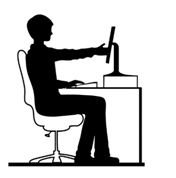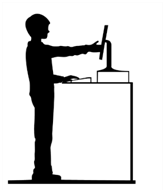Ergonomics is an expanding area of physiotherapy due to an increase in research based evidence emerging in recent years.
Many office workers come in to our clinic with pain that is largely attributed to the long hours spent at their desk daily, partnered with poor workstation equipment / setup.
When we sit in prolonged positions it places added strain on our muscles, ligaments and joints which then makes us more susceptible to neck, back, shoulder, arm and leg pain. Often these problems take time to rear their heads due to the cumulative strain effect, i.e. multiple micro injuries that build up over time.
Because of this cumulative effect, the best approach is prevention.
There are multiple things to consider in an office worker’s set up:
– How many hours a day do you spend at your desk?
– Do you get up for regular breaks?
– Is your desk adjustable?
Things to consider – your forearms should rest comfortably on the desk in a “propped” position (elbows off the desk); height of desk should be such that your shoulders are not bunched up around your shoulders, or sagging to reach desk height
– Is your chair adjustable?
Things to consider – chair height (feet should rest comfortably on the floor, with knees at roughly 90 degrees); chair depth (bottom should be at back of seat, entire length of thigh should be supported); chair angle (research suggests a recline of 10-15 degrees)
– Mouse / keyboard / screen setup
Things to consider – alternating between right and left hand for mouse use, to ensure you’re not overusing one side. If you suffer from wrist pain or elbow tendinosis check that your wrist is in a neutral position when you use your mouse.
Recent studies have researched the effect of prolonged sitting on health. In a typical 16 hour day, in addition to transport and leisure time, it is common for office workers to spend up to 80% of their day sitting. Excessive sitting time has been linked to a number of chronic conditions, including diabetes, heart disease, and colon cancer. This is independent of the amount of physical activity performed during the day – i.e. going for a 30 minute run at the end of the day does not counteract the time spent in sitting during the day.
Stretching:
Here are some simple stretches you can do at your desk to help minimise the effects of a desk based job.
– Shoulder rolls – roll your shoulders backwards 5- 10 times
– Neck stretches – tilt your right ear to your right shoulder and hold for 20 seconds. Then repeat on the Left side
– Stand up and arch your lower back backwards a few times. Do this gently.
– Stretch your arms overhead or behind you
– Stand up and twist gently from side to side.


